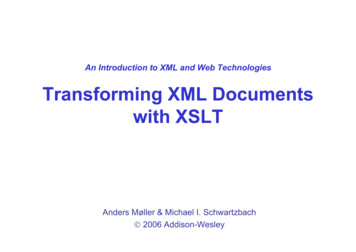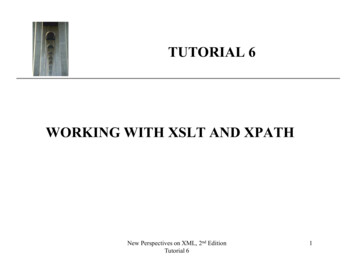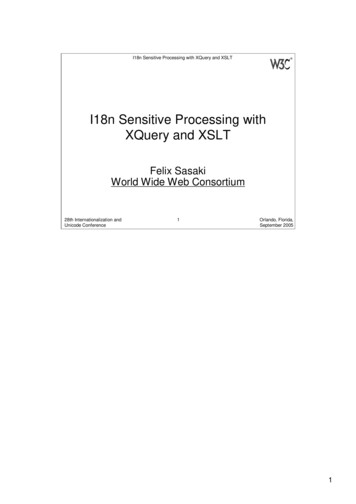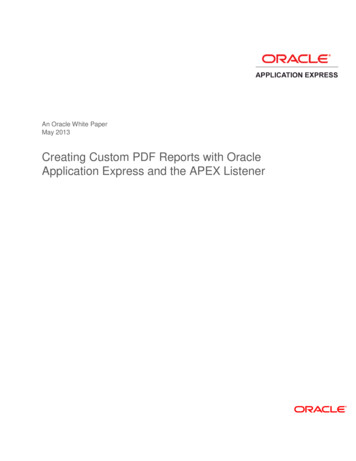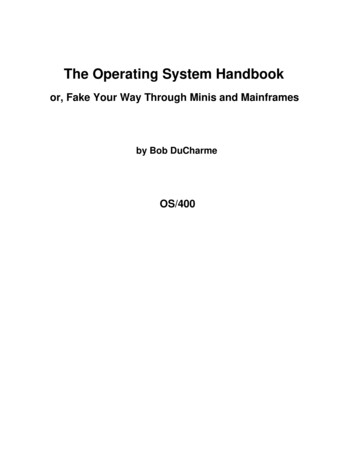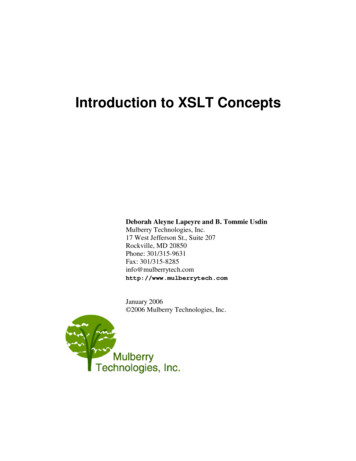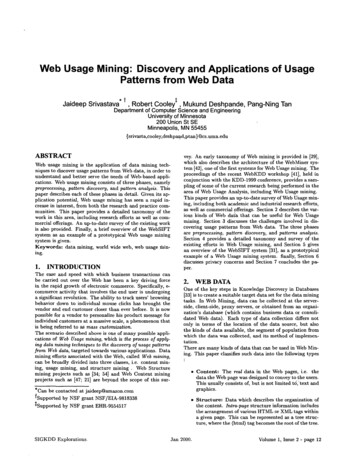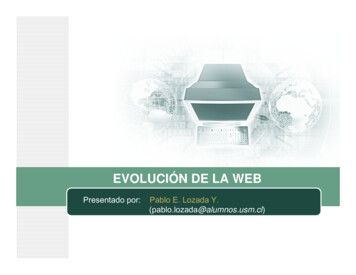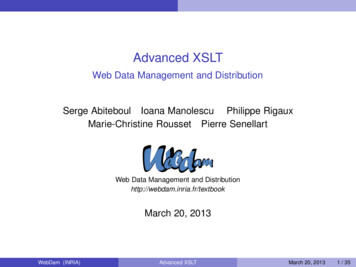
Transcription
Advanced XSLTWeb Data Management and DistributionSerge Abiteboul Ioana Manolescu Philippe RigauxMarie-Christine Rousset Pierre SenellartWeb Data Management and Distributionhttp://webdam.inria.fr/textbookMarch 20, 2013WebDam (INRIA)Advanced XSLTMarch 20, 20131 / 35
Stylesheets revisitedOutline1Stylesheets revisited2XSLT programming3Complements4Reference Information5Beyond XSLT 1.0WebDam (INRIA)Advanced XSLTMarch 20, 20132 / 35
Stylesheets revisitedThe children elements ofxsl:stylesheetimport Import the templates of an XSLT program, with low prioritiesinclude Same as before, but no priority leveloutput Gives the output format (default: xml)param Defines or imports a parametervariable Defines a variable.template Defines a template.Also: strip-space and preserve-space, for, resp., removal orpreservation of blank text nodes. Not presented here.WebDam (INRIA)Advanced XSLTMarch 20, 20133 / 35
Stylesheets revisitedStylesheet Output xsl:outputmethod "html"encoding "iso-8859-1"doctype-public "-//W3C//DTD HTML 4.01//EN"doctype-system "http://www.w3.org/TR/html4/strict.dtd"indent "yes"/ method is either xml (default), html or text.encoding is the desired encoding of the result.doctype-public and doctype-system make it possible to add adocument type declaration in the resulting document.indent specifies whether the resulting XML document will be indented(default is no ).WebDam (INRIA)Advanced XSLTMarch 20, 20134 / 35
Stylesheets revisitedImporting Stylesheets xsl:import href "lib templates.xsl" / Templates are imported this way from another stylesheet. Their precedence isless that that of the local templates. xsl:import must be the first declaration of the stylesheet. xsl:include href "lib templates.xsl" / Templates are included from another stylesheet. No precedence rule: worksas if the included templates were local ones.WebDam (INRIA)Advanced XSLTMarch 20, 20135 / 35
Stylesheets revisitedTemplate Rule ConflictsRules from imported stylesheets are overridden by rules of the stylesheetwhich imports them.Rules with highest priority (as specified by the priority attribute of xsl:template ) prevail. If no priority is specified on a template rule,a default priority is assigned according to the specificity of the XPathexpression (the more specific, the highest).If there are still conflicts, it is an error.If no rules apply for the node currently processed (the document node atthe start, or the nodes selected by a xsl:apply-templates instruction), built-in rules are applied.WebDam (INRIA)Advanced XSLTMarch 20, 20136 / 35
Stylesheets revisitedBuilt-in templatesA first built-in rule applies to the Element nodes and to the root node: xsl:template match "* /" xsl:apply-templates select "node()" / /xsl:template Interpretation: recursive call to the children of the context node.Second built-in rule: applies to Attribute and Text nodes. xsl:template match "@* text()" xsl:value-of select "." / /xsl:template Interpretation: copy the textual value of the context node to the outputdocument.Exercise: what happens when an empty stylesheet is applied to an XMLdocument?WebDam (INRIA)Advanced XSLTMarch 20, 20137 / 35
Stylesheets revisitedGlobal Variables and Parameters xsl:param name "nom" select "’John Doe’" / xsl:variable name "pi" select "3.14159" / Global parameters are passed to the stylesheet through someimplementation-defined way. The select attribute gives the default value, incase the parameter is not passed, as an XPath expression.Global variables, as well as local variables which are defined in the same wayinside template rules, are immutable in XSLT, since it is a side-effect-freelanguage.The select content may be replaced in both cases by the content of the xsl:param or xsl:variable elements.WebDam (INRIA)Advanced XSLTMarch 20, 20138 / 35
XSLT programmingOutline1Stylesheets revisited2XSLT programming3Complements4Reference Information5Beyond XSLT 1.0WebDam (INRIA)Advanced XSLTMarch 20, 20139 / 35
XSLT programmingNamed templates xsl:template name "print" xsl:value-of select "position()"/ : xsl:value-of select "."/ /xsl:template xsl:template match "*" xsl:call-template name "print"/ /xsl:template xsl:template match "text()" xsl:call-template name "print"/ /xsl:template Named templates play a role analogous to functions in traditional programminglanguages.RemarkA call to a named template does not change the context node.WebDam (INRIA)Advanced XSLTMarch 20, 201310 / 35
XSLT programmingParameters xsl:template name "print" xsl:param name "message" select "’nothing’"/ xsl:value-of select "position()"/ : xsl:value-of select " message"/ /xsl:template xsl:template match "*" xsl:call-template name "print" xsl:with-param name "message"select "’Element node’"/ /xsl:call-template /xsl:template Same mechanism for xsl:apply-templates .param describes the parameter received from a templatewith-param defines the parameter sent to a templateWebDam (INRIA)Advanced XSLTMarch 20, 201311 / 35
XSLT programmingExample: computing n! with XSLT xsl:template name "factorial" xsl:param name "n" / xsl:choose xsl:when test " n< 1" 1 /xsl:when xsl:otherwise xsl:variable name "fact" xsl:call-template name "factorial" xsl:with-param name "n" select " n - 1" / /xsl:call-template /xsl:variable xsl:value-of select " fact * n" / /xsl:otherwise /xsl:choose /xsl:template WebDam (INRIA)Advanced XSLTMarch 20, 201312 / 35
XSLT programmingConditional Constructs: xsl:if xsl:template match "Movie" xsl:if test "year < 1970" xsl:copy-of select "."/ /xsl:if /xsl:template xsl:copy-of makes a deep copy of a node set; xsl:copy copiesthe nodes without their descendant.RemarkAn XSLT program is an XML document: we must use entities for and &.XSLT is closely associated to XPath (node select, node matching, andhere data manipulation)WebDam (INRIA)Advanced XSLTMarch 20, 201313 / 35
XSLT programmingConditional Constructs: xsl:choose xsl:choose xsl:when test " year mod 4" no /xsl:when xsl:when test " year mod 100" yes /xsl:when xsl:when test " year mod 400" no /xsl:when xsl:otherwise yes /xsl:otherwise /xsl:choose xsl:value-of select "count(a)"/ xsl:text item /xsl:text xsl:if test "count(a) 1" s /xsl:if xsl:otherwise is optional. There can be any number of xsl:when ,only the content of the first matching one will be processed.WebDam (INRIA)Advanced XSLTMarch 20, 201314 / 35
XSLT programmingLoops xsl:for-each is an instruction for looping over a set of nodes.It is more or less an alternative to the use of xsl:template / xsl:apply-templates .The set of nodes is obtained with an XPath expression (attributeselect);Each node of the set becomes in turn the context node (which temporarilyreplaces the template context node).The body of xsl:for-each is instantiated for each context node. no need to call another template: somewhat simpler to read, and likely tobe more efficient.WebDam (INRIA)Advanced XSLTMarch 20, 201315 / 35
XSLT programmingThe xsl:for-each elementExample ( xsl:sort is optional): xsl:template match "person" [.] xsl:for-each select "child" xsl:sort select "@age" order "ascending"data-type "number"/ xsl:value-of select "name" / xsl:text is /xsl:text xsl:value-of select "@age" / /xsl:for-each [.] /xsl:template xsl:sort may also be used as a direct child of an xsl:apply-templates element.WebDam (INRIA)Advanced XSLTMarch 20, 201316 / 35
XSLT programmingVariables in XSLTA variable is a (name, value ) pair. It may be definedEither as the result of an XPath expression xsl:variable name ’pi’ăselect ’3.14116’/ xsl:variable name ’children’ăselect ’//child’/ or as the content of the xsl:variable element. xsl:variable name "Signature" Franck Sampori br/ Institution: INRIA br/ Email: i franck.sampori@inria.fr /i /xsl:variable RemarkA variable has a scope (all its siblings, and their descendants) and cannot beredefined within this scope.WebDam (INRIA)Advanced XSLTMarch 20, 201317 / 35
ComplementsOutline1Stylesheets revisited2XSLT programming3Complements4Reference Information5Beyond XSLT 1.0WebDam (INRIA)Advanced XSLTMarch 20, 201318 / 35
ComplementsOther XSLT featuresMany other instructions and functionalities. In brief:Control of text output xsl:text , xsl:strip-space , xsl:preserve-space , and normalize-spacefunction;Dynamic creation of elements and attributes xsl:element and xsl:attribute .Multiple document input, and multiple document output document function, xsl:document element (XSLT 2.0, but widelyimplemented in XSLT 1.0 as an extension function)Generation of hypertext documents with links and anchors generate-idfunction See the Exercises and projects.WebDam (INRIA)Advanced XSLTMarch 20, 201319 / 35
ComplementsHandling Whitespaces and blank nodesMain rulesAll the whitespace is kept in the input document, including blank nodes.All the whitespace is kept in the XSLT program document, except blank nodes.Handling Whitespace explicitly: xsl:strip-space elements "*" / xsl:preserve-space elements "para poem" / xsl:strip-space specifies the set of nodes whose whitespace-onlytext child nodes will be removed, and xsl:preserve-space allows forexceptions to this list.WebDam (INRIA)Advanced XSLTMarch 20, 201320 / 35
ComplementsDynamic Elements and dynamic attributes xsl:element name "{concat(’p’,@age)}"namespace "http://ns" xsl:attribute name "name" xsl:value-of select "name" / /xsl:attribute /xsl:element person age "12" name titi /name /person p12name "titi"xmlns "http://ns" / RemarkThe value of the name attribute is here an attribute template: this attributenormally requires a string, not an XPath expression, but XPath expressionsbetween curly braces are evaluated. This is often used with literal resultelements: toto titi "{ var 1}"/ .WebDam (INRIA)Advanced XSLTMarch 20, 201321 / 35
ComplementsWorking with multiple documentsdocument( s) returns the document node of the document at the URL sExample: document("toto.xml")/*Note: s can by computed dynamically (e.g., by an XPath expression). Theresult can be manipulated as the root node of the returned document.WebDam (INRIA)Advanced XSLTMarch 20, 201322 / 35
ComplementsUnique identifiers xsl:template match "Person" h2 id "{generate-id(.)}" xsl:value-ofselect "concat(first name, ’ ’, last name)"/ /h2 /xsl:template generate-id( s) returns a unique identifier string for the first node ofthe nodeset s in document order.Useful for testing the identity of two different nodes, or togenerate HTML anchor names.WebDam (INRIA)Advanced XSLTMarch 20, 201323 / 35
Reference InformationOutline1Stylesheets revisited2XSLT programming3Complements4Reference Information5Beyond XSLT 1.0WebDam (INRIA)Advanced XSLTMarch 20, 201324 / 35
Reference InformationXSLT 1.0 ImplementationsBrowsers All modern browsers (Internet Explorer, Firefox, Opera, Safari)include XSLT engines, used to process xml-stylesheetreferences. Also available via JavaScript, with various interfaces.libxslt Free C library for XSLT transformations. Includes xsltproccommand-line tool. Perl and Python wrappers exist.Sablotron Free C XSLT engine.Xalan-C Free C XSLT engine.JAXP Java API for Transformation. Common interface for various JAVAXSLT engines (e.g., SAXON, Xalan, Oracle). Starting from JDK1.4, a version of Xalan is bundled with Java.System.Xml .NET XML and XSLT library.php-xslt XSLT extension for PHP, based on Sablotron.4XSLT Free XSLT Python library.WebDam (INRIA)Advanced XSLTMarch 20, 201325 / 35
Reference InformationReferenceshttp://www.w3.org/TR/xsltXML in a nutshell, Eliotte Rusty Harold & W. Scott Means, O’ReillyComprendre XSLT, Bernd Amman & Philippe Rigaux, O’ReillyWebDam (INRIA)Advanced XSLTMarch 20, 201326 / 35
Beyond XSLT 1.0Outline1Stylesheets revisited2XSLT programming3Complements4Reference Information5Beyond XSLT 1.0WebDam (INRIA)Advanced XSLTMarch 20, 201327 / 35
Beyond XSLT 1.0Limitations of XSLT 1.0Impossible to process a temporary tree stored into a variable (with xsl:variable name "t" toto a "3"/ /xsl:variable ).Sometimes indispensable!Manipulation of strings is not very easy.Manipulation of sequences of nodes (for instance, for extracting all nodeswith a distinct value) is awkward.Impossible to define in a portable way new functions to be used in XPathexpressions. Using named templates for the same purpose is oftenverbose, since something equivalent to y f (2) needs to be written as: xsl:variable name "y" xsl:call-template name "f" xsl:with-param name "x" select "2" / /xsl:call-template /xsl:variable WebDam (INRIA)Advanced XSLTMarch 20, 201328 / 35
Beyond XSLT 1.0Extension FunctionsXSLT allows for extension functions, defined in specific namespaces. Thesefunctions are typically written in a classical programming language, but themechanism depends on the precise XSLT engine used. Extension elementsalso exist.Once they are defined, such extension functions can be used in XSLT in thefollowing way: xsl:stylesheetxmlns:xsl "http://www.w3.org/1999/XSL/Transform"xmlns:math "http://exslt.org/math"version "1.0"extension-element-prefixes "math" . xsl:value-of select "math:cos( angle)" / WebDam (INRIA)Advanced XSLTMarch 20, 201329 / 35
Beyond XSLT 1.0EXSLTEXSLT (http://www.exslt.org/) is a collection of extensions to XSLTwhich are portable across some XSLT implementations. See the website forthe description of the extensions, and which XSLT engines support them(varies greatly). Includes:exsl:node-set solves one of the main limitation of XSLT, by allowing to processtemporary trees stored in a variable. xsl:stylesheetxmlns:xsl "http://www.w3.org/1999/XSL/Transform"xmlns:exsl "http://exslt.org/common"version "1.0" extension-element-prefixes "exsl" . xsl:variable name "t" toto a "3" / /xsl:variable xsl:value-of select "exsl:node-set( t)/*/@a" / WebDam (INRIA)Advanced XSLTMarch 20, 201330 / 35
Beyond XSLT 1.0date library for formatting dates and timesmath library of mathematical (in particular, trigonometric) functionsregexp library for regular expressionsstrings library for manipulating strings.Other extension functions outside EXSLT may be provided by each XSLTengine.WebDam (INRIA)Advanced XSLTMarch 20, 201331 / 35
Beyond XSLT 1.0XSLT 2.0W3C Recommendation (2007)Like XQuery 1.0, uses XPath 2.0, a much more powerful language thanXPath 1.0: Strong typing, in relation with XML SchemasRegular expressionsLoop and conditional expressionsManipulation of sequences of nodes and values.New functionalities in XSLT 2.0: Native processing of temporary treesMultiple output documentsGrouping functionalitiesUser-defined functions.All in all, XSLT 2.0 stylesheets tend to be much more concise andreadable than XSLT 1.0 stylesheets.WebDam (INRIA)Advanced XSLTMarch 20, 201332 / 35
Beyond XSLT 1.0Example XSLT 2.0 StylesheetProduces a list of each word appearing in a document, with their frequency.(from XSLT 2.0 Programmer’s Reference) xsl:stylesheet version "2.0"xmlns:xsl "http://www.w3.org/1999/XSL/Transform" xsl:template match "/" wordcount xsl:for-each-group group-by "." select "for w in tokenize(string(.), ’\W ’)return lower-case( w)" word word "{current-grouping-key()}"frequency "{count(current-group())}"/ /xsl:for-each-group /wordcount /xsl:template /xsl:stylesheet WebDam (INRIA)Advanced XSLTMarch 20, 201333 / 35
Beyond XSLT 1.0XSLT 2.0 ImplementationsA few implementations.SAXON Java and .NET implementation of XSLT 2.0 and XQuery 1.0.The full version is commercial, but a GPL version is availablewithout support of external XML Schemas.Oracle XML Developer’s Kit Java implementation of various XML technologies,including XSLT 2.0, XQuery 1.0, with full support of XMLSchema. Commercial.AltovaXML Windows implementation, with Java, .NET, COM interfaces.Commercial, schema-aware.Gestalt Eiffel open-source XSLT 2.0 processor. Not schema-aware. . . a few others (Intel SOA Expressway, IBM WebSphere XML)WebDam (INRIA)Advanced XSLTMarch 20, 201334 / 35
Beyond XSLT ww.w3.org/TR/xslt20/XPath 2.0 Programmer’s Reference, Michael Kay, WroxXSLT 2.0 Programmer’s Reference, Michael Kay, WroxWebDam (INRIA)Advanced XSLTMarch 20, 201335 / 35
An XSLT program is an XML document: we must use entities for and &. XSLT is closely associated to XPath (node select, node matching, and here data manipulation) WebDam (INRIA) Advanced XSLT March 20, 2013 13 / 35. XSLT programming Conditional Constructs: xsl:choose xsl:choose
